Calla lilies unique flowers come in many colors, each with its own symbolism.
This guide will explore the colors, symbolism, and meanings behind calla lilies. You will also find helpful tips for growing and caring for these lovely plants.
From South Africa To The World: The History Of Calla Lilies
These flowers carry deep meanings and diverse symbolism across cultures. Their rich history dates back to South Africa, where they are native.
Calla Lily Origin South Africa
Native to South Africa’s marshlands, calla lilies thrive in warm, moist climates. These unique flowers have been cultivated globally for their beauty and symbolism.
Historically, calla lilies were used in various ceremonies, including weddings and funerals. Over time, these flowers spread beyond South Africa.
Here are some key points about the origins of calla lilies:
- Found in South Africa wetland areas.
- First cultivated by local tribes for their beauty.
- Exported to Europe and America in the 19th century.
- Adapted to various climates and conditions.
Today, calla lilies continue to enchant people around the globe. Their journey from South Africa to various gardens and homes shows their lasting appeal.
Popular Colors Of Calla Lilies: A Vibrant Spectrum
Each color of Calla lily carries its own symbolism and meaning. Understanding these colors helps in choosing the right flower for any occasion.
Yellow Calla Lily: Sunny Elegance
The yellow Calla lily radiates happiness and warmth. It is often associated with friendship, joy, and new beginnings. This vibrant flower brightens any space and uplifts the mood.
- Symbolizes joy and friendship
- Perfect for celebrations and special events
- Great for floral arrangements
These flowers bloom in late spring and summer. They thrive in well-drained soil and need plenty of sunlight.
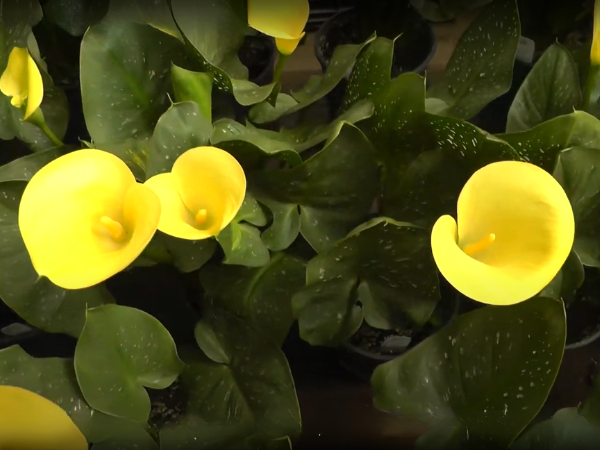
White Calla Lily: Timeless Purity
The white Calla lily stands for purity and innocence. It is often used in weddings and memorials. This elegant flower symbolizes rebirth and new beginnings.
- Commonly used in bridal bouquets
- Represents peace and tranquility
- Ideal for sympathy arrangements
These flowers bring a sense of calm and elegance to any setting.
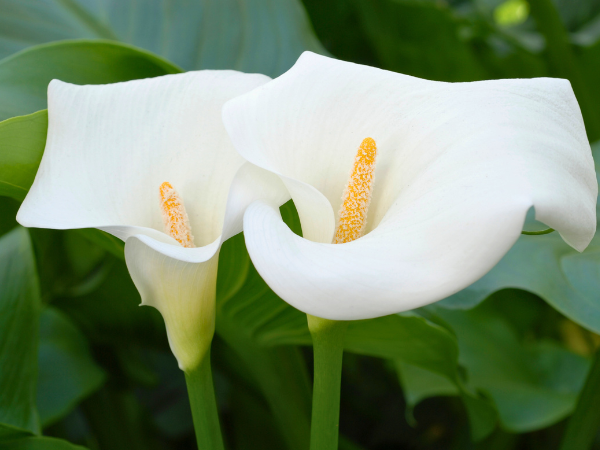
Black Calla Lily: Dramatic Sophistication
The black Calla lily exudes drama and sophistication. Its deep color adds mystery and elegance to arrangements. This flower symbolizes strength and authority.
- Popular in modern floral designs
- Great for formal events
- Represents elegance and power
This unique flower makes a bold statement in any garden or bouquet.
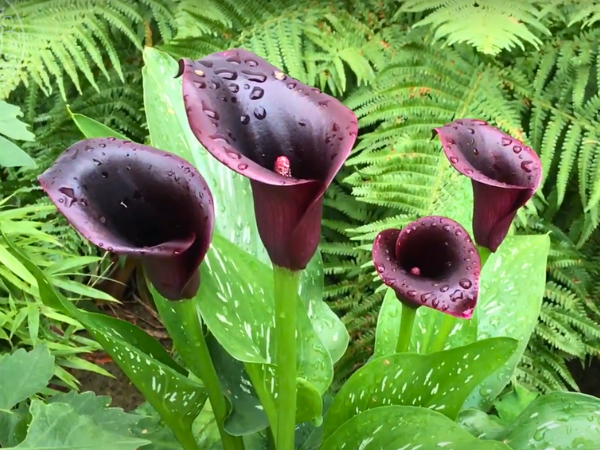
Purple Calla Lily: Regal Charm
The purple Calla lily brings a sense of royalty and charm. It represents admiration and respect. This color is perfect for expressing deep feelings.
- Symbolizes admiration and love
- Great for romantic occasions
- Adds a touch of luxury to arrangements
These flowers enhance the beauty of gardens and homes with their regal look.
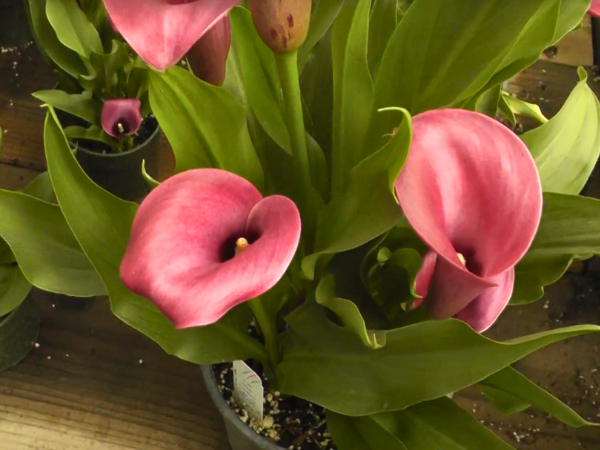
Red Calla Lily: Bold Passion
The red Calla lily symbolizes bold passion and desire. It is a favorite for romantic occasions and expresses strong emotions. This vibrant flower captures attention with its striking color.
- Perfect for Valentine’s Day bouquets
- Represents love and desire
- Ideal for passionate events
With their bold hue, these flowers make any arrangement unforgettable.

Calla Lily Flower Meaning & Symbolism
Understanding the symbolism of the Calla Lily offers insight into its importance in different contexts. It represents significant emotions and moments in life.
A Symbol Of Purity, Elegance, And Transition
The Calla Lily is a powerful symbol of purity and innocence. Its pristine white petals evoke a sense of cleanliness and simplicity. This flower is often used in weddings, representing the love and commitment shared between partners.
Here are some key meanings associated with Calla Lilies:
- Purity: Their white color symbolizes purity and virtue.
- Elegance: The sleek shape reflects sophistication and grace.
- Transition: Commonly associated with rebirth, they signify new beginnings.
Calla Lilies come in various colors, each carrying its own unique meaning:
| Color | Meaning |
|---|---|
| White | Purity and innocence |
| Pink | Admiration and appreciation |
| Yellow | Joy and gratitude |
| Purple | Royalty and admiration |
This makes the Calla Lily perfect for various occasions, from weddings to funerals. It beautifully symbolizes both joy and sorrow, capturing the essence of life’s transitions.
Historical And Cultural Significance
From ancient Greek mythology to modern-day events, Callas carry deep meaning. In Greek culture, the flower is linked to the goddess Hera. It represents beauty and fertility.
Across different cultures, Calla Lilies have been used in ceremonies:
- Weddings: A symbol of love and commitment.
- Funerals: Represents the transition to the afterlife.
- Celebrations: Used in various cultural festivals to signify joy.
In art, Calla Lilies have inspired many famous paintings. Artists like Georgia O’Keeffe featured them prominently. Their unique shape and vibrant colors have made them a favorite subject.
Calla Lily Blooming And Growth Habits
Understanding its blooming and growth habits helps in caring for these beautiful plants. Let’s explore when these lovely flowers bloom, whether they spread, and how long potted Calla Lilies last.
When Do Calla Lilies Bloom?
Calla Lilies bloom in late spring to early summer. The exact timing may vary by region and variety. In warmer climates, you might see blooms as early as April. In cooler areas, they may wait until June to show their beauty.
- Most varieties bloom for 6-12 weeks.
- Proper watering and light can extend the blooming period.
- Flowers can last longer with regular care.
These blooms appear on tall stems, making them stand out. Below is a table of common Calla Lily varieties and their bloom times:
| Variety | Bloom Time |
|---|---|
| Calla Lily ‘Black Magic’ | Late Spring |
| Calla Lily ‘Captain Safari’ | Early Summer |
| Calla Lily ‘Pink Melody’ | Late Spring to Early Summer |
Understanding these details helps gardeners prepare for the beauty of Calla Lilies.
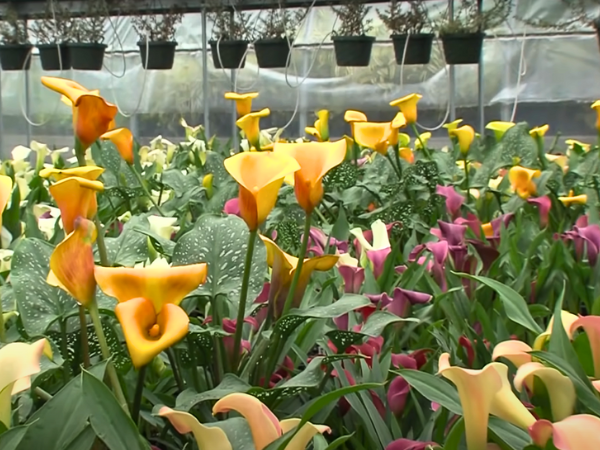
Do Calla Lilies Spread?
Yes, Calla Lilies spread. They multiply via rhizomes, which are underground stems. These rhizomes store nutrients and can produce new plants. Here are some points to consider:
- Calla Lilies can be divided after dormancy.
- Dividing helps control their spread.
- Spacing is essential to avoid overcrowding.
To divide, wait until the plants go dormant in the fall. Carefully dig up the rhizomes and separate them. Replant the divisions in well-draining soil.
How Long Do Potted Calla Lilies Last?
Potted Calla Lilies can last several weeks indoors. They typically bloom for 6–12 weeks with proper care. Factors like light and watering play a big role. Here are some tips to extend their lifespan:
- Provide bright, indirect sunlight.
- Water regularly but do not overwater.
- Use well-draining potting mix.
With the right conditions, potted Calla Lilies thrive. They can be grown indoors in pots or outdoors in warm, frost-free climates. Regular care ensures healthy blooms and prolonged enjoyment.
Growing Calla Lilies Indoors Vs Outdoors
Growing calla lilies indoors vs outdoors can be a bit different. Each environment has its own requirements.
Is A Calla Lily An Indoor Or Outdoor Plant?
Calla lilies are versatile plants. It can thrive both indoors and outdoors, just adjust light and watering needs. Here are some key points to consider:
- Indoors: Ideal for pots on windowsills or tables.
- Outdoors: Perfect for garden beds or borders.
- Growing season: Best in spring and summer.
Consider the climate in your area. Calla lilies prefer warm temperatures. They can withstand mild winters, but extreme cold can harm them. Here’s a simple comparison:
| Feature | Indoor | Outdoor |
|---|---|---|
| Light | Bright – indirect light | Full sun to partial shade |
| Watering | Keep soil moist | Water regularly, especially in hot weather |
| Temperature | Room temperature | Above 60°F (15°C) preferred |
Choose your growing method based on your space and conditions. Both options can yield beautiful blooms.
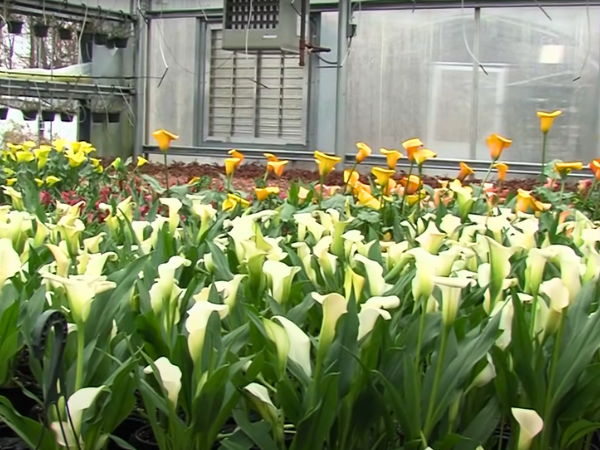
Light And Temperature Needs
Bright – indirect light indoors works best. Place them near a window with filtered sunlight. Too much direct sunlight can scorch the leaves. Outdoors, they enjoy full sun to partial shade. Morning sun with afternoon shade is ideal.
Temperature also matters. Calla lilies prefer warm conditions. Ideal temperatures are between 65°F to 75°F (18°C to 24°C). Protect them from frost. If temperatures drop below 50°F (10°C), consider moving them indoors.
Here are some tips for light and temperature:
- Check for adequate light daily.
- Adjust indoor plants as seasons change.
- Monitor outdoor plants during extreme weather.
Proper light and temperature help calla lilies thrive. Healthy plants produce more flowers.
Potting And Repotting Tips
Choose well-draining soil. A mix of potting soil and perlite works well. This helps prevent waterlogging, which can lead to root rot. Select a pot that is at least 12 inches deep for adequate root space.
Repotting is necessary when the rhizomes get crowded. Check your plants every year. If you see roots growing out of the drainage holes, it’s time to repot. Here’s how to repot:
- Gently remove the plant from its current pot.
- Trim any dead or damaged roots.
- Place it in a larger pot with fresh soil.
- Water thoroughly after repotting.
Repotting encourages growth. Healthy rhizomes lead to stunning blooms. Monitor your plants and adjust care as needed.
Calla Lily Plant Care Essentials
Understanding how to care for this stunning plant is essential for healthy growth and blooming. Here are the Calla Lily plant care essentials that will help you nurture these lovely flowers.
Watering Schedule And Soil Needs
These plants thrive in moist, well-drained soil. Avoid soggy roots, as this can lead to rot. Here are some key points for watering and soil needs:
- Water deeply but infrequently.
- Check the top inch of soil; it should feel dry before watering.
- Use pots with drainage holes to prevent water buildup.
For soil, choose a mix that retains moisture without becoming waterlogged. A good mix includes:
| Soil Type | Benefits |
|---|---|
| Potting Soil | Good drainage and nutrient retention. |
| Pearlite | Improves aeration and drainage. |
| Compost | Adds nutrients and enhances soil structure. |
Make sure to water your Calla Lily regularly during the growing season. Adjust the frequency based on weather conditions.
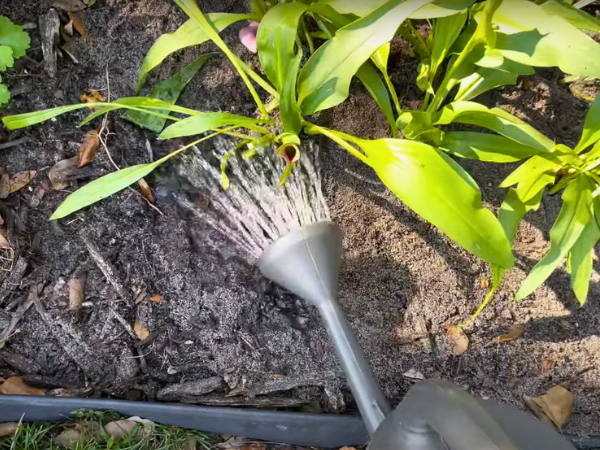
Fertilizing Tips For Healthy Blooms
Use a balanced fertilizer every month during the growing season. This helps supply the nutrients needed for growth and flowering. Here are some tips for fertilizing:
- Choose a fertilizer with equal parts nitrogen, phosphorus, and potassium.
- Follow the instructions on the package for mixing.
- Apply fertilizer after watering to avoid root burn.
During the blooming period, watch for signs of nutrient deficiency. Yellowing leaves can indicate a need for more nutrients.
Dormancy And Seasonal Care
Calla Lilies enter a period of dormancy after blooming. This is a natural part of their life cycle. Let the plant rest after blooming—cut back and reduce watering. Here’s how to care for your plant during this period:
- Stop watering once the leaves start to yellow.
- Cut back the foliage to about 2 inches above the soil.
- Store the pot in a cool, dry place.
Keep the temperature between 50-60°F. Resume watering when new growth appears in spring. At this time, move the plant back to a sunny spot.
Calla Lilies And Pet Safety: Toxicity To Cats And Dogs
Calla lilies can be toxic to both cats and dogs. This section will explore the toxicity of calla lilies and provide important safety tips for pet owners.
The Dangers Of Calla Lilies For Cats
Calla lilies can pose serious risks for cats. These plants contain calcium oxalate crystals. Toxic if ingested, these crystals can lead to painful symptoms. Here are some common issues cats may face:
- Drooling
- Vomiting
- Difficulty swallowing
- Oral irritation
If a cat chews on or eats any part of a calla lily, it may show signs of distress. Immediate veterinary care is crucial. Symptoms can escalate quickly. Pet owners should be vigilant and monitor their cats around these plants. Keep calla lilies out of reach.
Understanding Calla Lily Toxicity In Dogs
Calla lilies are also harmful to dogs. Dogs may show various symptoms after eating parts of the plant. Common reactions include:
- Pawing at the mouth
- Oral irritation
- Vomiting
- Excessive drooling
Pet owners should act quickly. Keep plants out of reach to avoid symptoms. If a dog consumes a calla lily, it can lead to discomfort and pain. Symptoms may vary in severity. Some dogs may only experience mild irritation, while others can have severe reactions.






